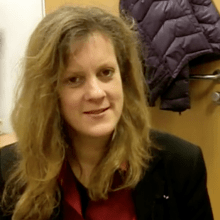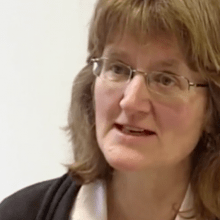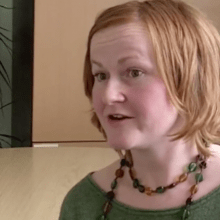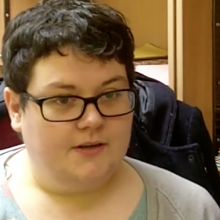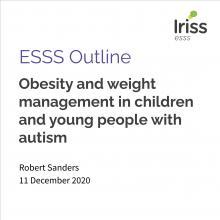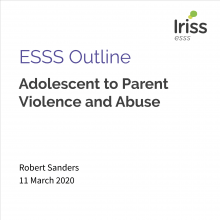Dr Nancy Lombard talks about her research conducted with 89 primary school children in Glasgow. The research explored their views on violence, particularly about violence against women. The research involved an exploratory questionnaire, group discussion sessions and discussions of case studies.
Nancy found that young people described violence as something involving adults, usually adult men, they did not tend to see behaviour amongst themselves in this way. They also associated violence with being in a public place, involving physical force, having a consequence and authority intervening. They defined violence between themselves, particularly between siblings, as "normal". They also were unlikely to see actions as violent if they did not involve someone from authority intervening.
When talking about violence against women the young people justified a lot of the violence, identifying that the triggers for the violence were things the woman had or hadn't done.
When girls talked about be an adult they expected their aspirations to narrow once they were married. At this stage they talked about working in part-time jobs rather than engaging in full-time careers. This narrowing didn't happen with the boys, even those who talked about getting married and having children.
Given the importance of authority intervening identified in this reasech there are potentially implications here for schools in ensuring they challenge violent behaviour (of all forms). There are also lessons about ensuring violence between siblings is challenged, and not excused as being "normal".
Further, securing access through the schools for this research also revealed that some schools considered that domestic violence was not an issue in their area. This misunderstanding about the nature and extent of domestic violence could potentially be making it more difficult for pupils and parents for who this is an issue to find support through the school.
Further information on the research
Lombard N (2011) Young people's attitudes about violence (PDF), Edinburgh: CRFR.
The research that I did involved primary school children in Glasgow. So I spoke to 89 primary school children. I used a variety of methods - an exploratory questionnaire, discussion group sessions with friendship groups and vignettes, so I gave them a situation to discuss in the groups. So the research took 6 months and the findings came from analysing all of these various methods and the data from that.
What I found was that ... there were several findings - I think the main findings were that young people described violence as something that happened to adults - they described it as a sequence of events that involved adult men, in public places, using physical force, with the consequence and the intervention of authority. So a perfect example of this would be two men outside a pub fighting, they hit each other, one of them is injured and then the police come and arrest them. So young people, when they spoke about 'real' - they called it 'real' violence, that is what they described.
When they talked about experiences within the school, they also described behaviour that could mirror some of this, but because it involved themselves and it was within the school, they were less likely to describe it as violence. And this was very much the case with young girls who normalised a lot of the experiences that they had. So the young boys would be quite physically violent and quite abusive, verbally abusive and emotionally abusive to girls - but because there wasn't an intervention from adults, the young girls learned to normalise this behaviour, and they didn't see it as 'real' violence. And this is replicated in a lot of feminist literature where women normalise the violence that they will experience. So what I found was that this is happening at a very young age.
Both boys and girls within the home normalised violence that was either perpetrated against them or that they perpetrated among their siblings. So there were occasions where "it's my brother - I hit him, but it's not real violence, it's a kid on, it's dummy fighting". But some of the injuries that they described - black eyes, broken bones, bruises and cuts were really quite serious. But because the parents would say ... would normalise the behaviour because it was siblings, and "that's what siblings do", that was another form of experience that was normalised for the young people.
When we spoke about violence between men and women in the groups, the young people justified a lot of the violence that men perpetrated to women, and they justified this using a heterosexual framework in which to understand the violence. So they very much understood heterosexuality and a heterosexual relationship as a dominant man and a more passive woman. So occasions in the vignettes where situations were discussed such as tea not being ready and a man being angry, or a lady having an affair and the man hitting her - the triggers were seen by the young people that it was because of what the woman did or didn't do that the man was violent. So they justified the violence using ideas of men's dominance, men's right to control, men's right to privilege and men's "natural" strength and dominance. So if a situation arose where a man used violence, the young people understood it and explained it because of the behaviour of the woman. So if she had have made tea, he wouldn't have got angry and hit her. If she hadn't have had an affair, he wouldn't have got angry and hit her. So there was a real anger issue there as well - she made him angry. And a lot of the young people understood heterosexuality in the same way that they understood parent child relationships - with the parent being in charge and having control, and needing to do as they were told. So that was another way that young people explained - they very much thought that women should be obedient and do as they were told.
This was not replicated in their own experiences of childhood - they didn't see themselves ... the girls didn't see themselves as needing to be dominated or controlled by the boys. There were situations where they did find themselves controlled, such as space in the playground which was very much dominated by boys, but girls very much saw themselves as equal to boys at this stage. And part of the research demonstrates that young girls felt that they were equal, they were happy, they had ambition, the world was their oyster basically, and they saw their gender identities as very fluid and very able to be changed depending on how they chose to do so. So the choices that were available to them at a young age were vast and the young people recognised that. But when the girls spoke about being adults, they saw their gender identity as becoming very narrowed and very fixed and very stable. And they saw this as happening because they would get married and they would have children. So it was almost like a narrowing, it was a triangle, so it was opportunities now "when I'm now" and then narrowing into "when I'm older" and "when I'm married". And I think one of the best demonstrations of this was in 2 separate parts of the research, young people would talk about ... young girls would talk about how they wanted to be doctors, how they wanted to be surgeons, how they wanted to be teachers - a whole range of ideas of job choices. And then later in the research when they spoke about being older, they would talk about when they were married, when they had children - they would work part time, they would work in a shop, they wouldn't have many friends, they would maybe have one friend - and this was quite a pertinent part of the research and something that I hadn't anticipated. This didn't happen with the boys - the boys again had all these ambitions, all these ideas of what they wanted to achieve, and they still thought that was possible when they were older. So there was no narrowing of their ambitions. But there was talk of maybe them getting married, maybe them having children, but this was almost incidental to their lives - it wasn't a main part of their identity as an adult. The implications - I think there are implications directly for schools in particular, I think the idea that young people reacted to authority telling them what was right and wrong I think is very important, and it's a very important lesson for schools. So young people needed a teacher to intervene and say "stop doing that". When it didn't happen, or when the teacher brushed it off, the young girls felt that their experiences were minimised and normalised. So I think there is definitely room for improvement in terms of how teachers deal with confrontation and interactions between boys and girls and recognising that girls might experience that in a different way than boys do. A lot of the young people that I spoke to were very happy, they were very articulate - I think one thing that it demonstrated to me was that parents were very happy to let their child make choices about taking part in the research and the school less so. Whereas the parents were saying "let them decide". So I think ... I don't think there's a need for parents and schools to work more closely because I think that was happening in lots of occasions. I think there are issues to address in terms of the minimising the violence and the normalising of violence that is happening within the home in terms of siblings. I think that was something that I hadn't anticipated from the research, and I think that's ... maybe in the same way that domestic abuse was seen in the '70s as something that went on behind closed doors, a lot of parents are saying "well that's what brothers and sisters do". But it's not, that's not normal behaviour for brothers and sisters, or sisters and sisters or brothers and brothers to express themselves through violence. So I think maybe that is a message for parents to try to intervene more to try and stop that kind of behaviour. I think there were also issues ... there were several disclosures during the course of the interviews from young people themselves about things that were going on at home - their understanding of domestic abuse was text book, because it was something that was happening to them. Most of the schools were aware of this issue within the home, but I think one of the limitations when I first approached schools, was that several schools still said "we don't have domestic abuse in this area - we live in this area of Glasgow and we don't have a problem with that". And I think to still believe that domestic abuse only happens in certain cultures, in certain classes - schools need to be aware that it's classless and it happens across cultures, it happens in all areas of Glasgow - and I think if a school is having that opinion, then it is going to be a lot harder for that woman, that mother, that child to step forward and to say "we have got a problem here", if they think it is not an issue for us. I think there was also, in terms of refusing access, some of the schools also talked about "young people don't learn about domestic abuse until secondary school, so there is no point coming and talking". So there was a reluctance to see that actually young people can talk about a whole range of issues, whether they have experienced it themselves or not, because young people have lots of opinions and can talk about lots of different things, and all the young people were more than happy to sit and to chat to me for an hour and were really pleased that they were actually being listened to and had a chance to have a discussion about an issue that other adults might not choose to speak to them about. So I think the sensitivities around the issues of violence and the issues of gendered violence in particular are very much the adult sensitivities - the young people don't share those same beliefs.

